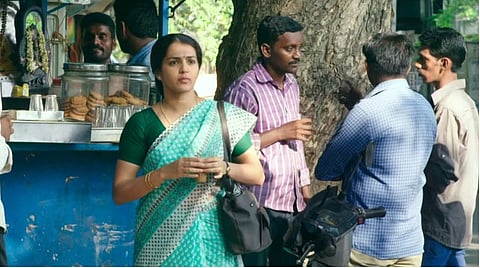Sivaranjaniyum Innum Sila Pengalum Movie Review: A disturbing glimpse into the life of women
Rating:(4 / 5)
The trysts between modern Tamil cinema and Tamil literature are few and far between. Even when filmmakers opt to shuffle through the rich libraries of Tamil literature, they end up picking stories that are sensational or high in conflict. The stories of the common man like the one we find in the books of Ashokamitran and Sundara Ramaswamy are apparently too subtle for our cinema sensibilities. Director Vasanth Sai seems determined to change that. His screen adaptation of T Janakiraman’s Payasam for Netflix’s Navarasa provided hope. His latest release—and an older film for the director—Sivaranjaniyum Innum Sila Pengalum (first premiered in the Jio MAMI 20th Mumbai Film Festival 2018), now reinforces it.
Director: Vasanth S Sai
Cast: Parvathy Thiruvothu, Kalieswari Srinivasan, Lakshmi Priyaa Chandramouli
Based on the works of Ashokamitran, Adhavan, and Jeyemohan, Sivaranjaniyum Innum Sila Pengalum, an anthology, has three segments set in three different periods 1980, 1995, and 2007. Each one depicts the everyday life of a woman. Irrespective of the time, in each segment, the woman protagonist finds herself constrained by man or men or even by women.
In fact, there is more in common between Saraswathi (Kalieswari Srinivasan) of the 80s and Sivaranjani (Lakshmi Priyaa Chandramouli) of the 2000s. For one, both have a daughter. Saraswathi is married to a wife-beater, who leaves her when she stands up to him. Mind you, she doesn’t even retaliate. Sivaranjani’s husband might not be that violent, but her predicament is eerily similar despite the difference in social status. They are both treated almost as servants. Saraswathi, in fact, even seems better off at the end than Sivaranjani.
Sivaranjani, who had to give up her career as an athlete, finds herself running errands at her home. It is excruciating to see her toil. No palpable violence is inflicted upon Sivaranjani, but her exhaustion and claustrophobia are glaring. A misplaced file is her fault. A small delay in fetching the mobile invites a grumble. Her mother-in-law speaks no harsh words, but it is infuriating when she says, “Un samayal enakku oththu varaathu. Naane paathukuren.” This is the only segment, in which the woman doesn’t find freedom from her household. Her redemption is more inwards. Must Sivaranjani’s achievements at home be compared to the ones on the ground though? I’m not so sure.
My favourite of the segments in this anthology is Devaki. Parvathy Thiruvothu plays a working woman in the 90s trying to find her own space in a joint family. Unlike in the other two segments, here, we don’t follow the woman but her young nephew. We get to see Devaki through the perspective of this young boy, who is curious about the world of adults. The conflict in the family arises when he tells the adults that his aunt keeps a secret diary.
It is breathtaking to see how Vasanth has captured all these stories with such intimacy despite canning only a few close-ups of the lead actors. Be it the last shot of Sarswati or the juxtaposition of Sivaranjani toiling in the kitchen and her husband having his breakfast in the bed, or the scene where Devaki stands as the only woman drinking tea at the roadside shop, every shot tells. Perhaps no other contemporary filmmaker captures our homes as realistically as Vasanth. This makes it a disturbing watch because these are our homes, and the women of this film are those in them. The film never takes a didactic tone. There is no dialogue asking for women empowerment nor an accusatory word towards men. And yet, it manages to create guilt… for the men, of course.
It has taken about three years for the anthology to get released since its premiere. However, even if this film were to get released a decade later, I dare say it would still be relevant.

